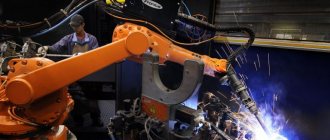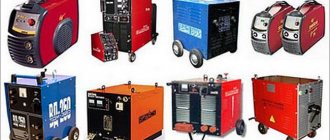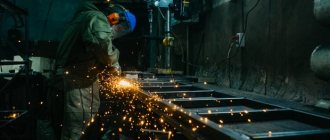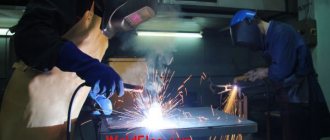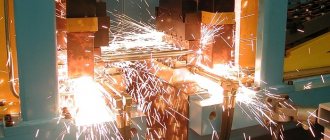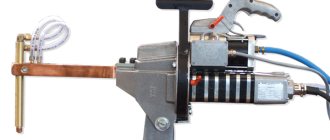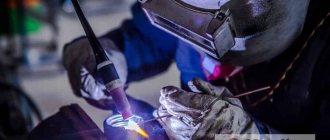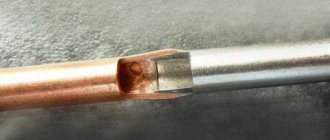Robotic welding is a type of automated process characterized by high precision. Programmable robots replace welders and increase work productivity tenfold. A welding robot is an essential part of a conveyor production where there are welding operations. For example, when assembling cars, household appliances, equipment.
The essence and application of robotic welding
Robots perform welding work for many hours. They don't need lunch breaks. Some models operate during power outages or network sag. Robotic welding is effective for large volumes. Before the welding operation, robots correctly position the parts and install them with the required clearance. They do this with a manipulative hand much more accurately than a human. The seam is smoother. The size of the part does not matter for robotic welding, the “arm” can be adjusted to any distance.
With the help of robots, metal is welded and cut; spot, electric arc, and argon welding are more often used; it is permissible to form a welded joint using flux. Manipulators create a uniform seam bead, mechanization eliminates the human factor, there is no need to monitor the melt pool, an arc of several millimeters is maintained automatically. The gasket is not affected by the position of the workpiece grip; the grip deviation does not exceed 5 mm.
Welding robots are used in the assembly of cars, household appliances, and equipment. Very often they are used not only to weld, but also to cut metal.
general information
Robotic welding is a type of automatic welding, the essence of which is the use of programmable robots in production instead of conventional welders. Such welding is in great demand at enterprises where it is necessary to set up large conveyor production.
There are a huge number of varieties of welding robots, as each manufacturer strives to equip its equipment with special functions. Despite the technical complexity, competition among manufacturers of welding robots is very high, because such equipment is expensive and is often purchased for more than one year. Therefore, manufacturers are trying to equip their robots with the maximum number of useful functions.
Budget, but relatively functional robots are produced by the Japanese company Fanuc. Their most popular model is the AM-0iA. German welding robots from Kuka are popular among European manufacturers, especially their budget model KR5. We also note welding robots from the world-famous company Panasonic, in particular their model TA1400G2 has proven itself well in domestic factories. Motoman's products performed well; the EA 1400N model deserves special praise.
Welding robot device
An automated device is an apparatus mounted on a solid base with an articulated rotating mechanism. The body rotates freely around its axis. The welding robot is equipped with:
- current source;
- current-voltage characteristics converter;
- feeding device.
A display, a remote control with software, and an inert gas cylinder are provided. The controlled “arm” consists of several parts. From three to six segments are connected by rotary units. A gas burner is attached to the end of the manipulator arm, an additive - welding wire - is automatically supplied to the working area, and a protective atmosphere is created by supplying gas.
What are the different welding methods?
It is customary to distinguish several types of welding:
- Point-contact. One of the most common. For this type of welding, the device is equipped with special pliers. The most common type.
- Dugovaya. It has also become widespread. However, this type requires a greater number of degrees of freedom so that the welding head is positioned strictly perpendicular to the seam.
- By friction and movement method. A welding robot spins a tool - a rod. A special tip is installed in it. Welding occurs by heating the element to high temperatures. The robot moves smoothly along the entire welding line.
- Laser. Used for high speed welding. Practically does not emit caustic substances into the atmosphere.
- Ultrasonic. Most often used in welding integrated circuits. The welding head consists of a waveguide, an ultrasound generator, and a welding needle.
To ensure that the process goes faster and the welding accuracy does not deteriorate, you need to properly organize the workspace.
Advantages and disadvantages
Robotic welding optimizes the technological process; robotic machines have replaced welders. Advantages of work automation:
- the quality of connections improves;
- similar operations are performed at the same speed (a person is not capable of this);
- equipment can be reconfigured during operation in a matter of minutes;
- the defect rate decreases;
- stable arc burning is maintained, the interval between the workpiece and the electrode is maintained;
- the operating time is much longer;
- equipment costs quickly pay off due to the elimination of manual labor and increased productivity;
- maintenance costs are disproportionately less than the salary fund of welders with mandatory deductions;
- the operator setting up the equipment acts according to modified algorithms that do not require special knowledge; it does not take long to train him;
- safety - no thermal or radiation effects on people;
- economic effect;
- no control system is needed; this function is performed by a computer.
Now about the disadvantages, they also exist:
- high cost of robots;
- repeatability of operations, you won’t be able to reconfigure the automation, robotic welders are used only in conveyor assembly and mass production;
- The quality of welding work depends on the operator’s experience and ability to set up equipment.
How to achieve robotic welding precision?
There are four ways to increase the accuracy of work:
- Elimination of inaccuracies in the assembly of robot joints, correction of errors in zero sensors, which are responsible for the angles of rotation of the robot joints. To reduce the effect of these factors to a minimum, you need to use special software that takes into account such errors.
- Entering G-codes. Using special programs that correctly convert three-dimensional CAD/CAM files into G-codes.
- Reduction of microvibrations. They occur due to the use of low-backlash gearboxes in robots. Sometimes micropulses occur, which can affect the accuracy of welding. Leading manufacturers take this factor into account. They include in the program code “a method of additional signals in the motor inertia moment command.” This reduces the amount of vibration and resonance to zero.
- Control of the robot's coordinate system. Special program code that takes into account the displacement of the tip of the welding machine after finishing work. Also known as the "tool measurement method".
And the most important thing is timely maintenance and regular maintenance of the automatic welding device.
Types of welding robots
Robotic models for welding have been developed and produced:
- consumable electrode;
- welded wire;
- tungsten and graphite rods;
- contact copper-containing electrodes (spot welding);
- plasma;
- laser.
Some manufacturers have launched the production of hybrid modifications. The main differences between welding robots:
- manipulator length;
- the number of repeated parts in the “arm”;
- functions performed.
Nuances of work
The basic requirements are listed above. They should be observed in any production using robotic devices. But there are also certain nuances that are encountered in welding shops when welding automobile or other bodies, as well as when working in a protective gas environment.
Features of robotic gas shielded welding
This type of welding device is in demand in large industries. It is not practical to use them for small-scale assembly. You should also take into account that most models emit harmful substances. Welding takes place in an aggressive environment (argon and carbon dioxide). Basic requirements for TB:
- The robot operator should not remain in close proximity to the operating device for long periods of time. The welding line should be located in a separate workshop or isolated room.
- In production, it is necessary to provide high-quality ventilation to remove corrosive gas from work areas.
These requirements must be observed so that a person does not receive poisoning or chemical burns at work.
Body welding by robots
Robotic welders are most common in the automotive industry. Automatic joining of parts into one body is what all plant owners have been waiting for since the middle of the last century. Robot welding of cars is used everywhere. But even before introducing automatic devices into the line, several features need to be taken into account:
- Draw up a full-fledged project and calculate the estimate. Calculate in advance the total number of welding devices, positioners, clamps that will work on the line.
- Embed potential growth. Equip the conveyor in such a way that later it can produce a larger number of bodies.
- Take care of safety regulations and requirements. They may differ depending on the type of machines used.
It is best to choose robotic devices that have already proven themselves in the market.
Automated line for welding car bodies
Interesting! VOLGABUS has reduced the production time of bus bodies by 30 times after introducing a fully automatic assembly and welding line. 29 devices from KUKA were purchased as welding robots.
Equipment setup
Welding robots include stages of setting up robotic equipment:
- Calibration of the external axes of movement of the robotic manipulator when installing in position. The operator checks the operating mode indicators on the display: seam length, trajectory. The shape of the weld seam depends on the accuracy of the installation of the external axes. Deviations of a few millimeters lead to defects.
- Setting up the “hand” with the tool, coordinating the movements of the welding head substrate and the clamping mechanism. They must move in concert, otherwise the welding will not be on the workpiece, but on the movable clamping mechanism or manipulator.
- Environment coordination. Typically, several welding robots are installed on a conveyor at once; they should not interfere with each other. A model of the welding process is created together with other robotic manipulators working in parallel.
The first two settings are required after connecting the robotic welding equipment to the network in order to install it correctly.
Pre-calibration by default. Conducted by factory operators. Welding ports and clamping mechanisms are calibrated to microns when interacting.
Increase your enterprise productivity
Welding automation is a process that improves the quality of a production line and speeds up the production process. By introducing robotic welding at an enterprise, the owner saves on labor and increases productivity by reducing the amount of scrap produced.
Thanks to increased productivity, it is possible to quickly recoup the funds invested in automation and gain profit. Each robotic arm can be configured individually so that it performs the type of work that is needed specifically at a particular enterprise. If you still have questions about production automation and the introduction of welding robots into the work of the enterprise, please contact us!
Placement of a robotic welding complex
When installing a robotic welding complex into a working position, a number of rules are observed:
- the thickness of the concrete floor is at least 30 cm;
- surface irregularities greater than 5 mm are not acceptable;
- fixation is carried out with removable anchor bolts, eliminating shift due to vibration;
- the work area is fenced off with warning tape or portable yellow fence panels;
- the size of the security zone is at least 1.5 meters;
- provision is made for connecting an overhead wire to cool the connection;
- electrical wiring is laid in metal cable channels.
The software is configured only after the robot has been positioned.
Organization of robotization of welding production
First, you need to understand that robotic devices are not suitable for all areas. The same rule applies to welding shops. There are areas in production where humans will surpass robots in speed and quality of work. In addition, his labor will be cheaper. Therefore, it is necessary to calculate in advance the economic indicators of each process (operation) and only then replace some of the personnel with robots.
Today, collaborative models of robots are more common, when a person works in tandem with a robot. It turns out that it is necessary to create conditions for both a person and an electromechanical device. Namely:
- Protect personnel from injury when working near a robotic device (arrange safety zones, partially enclose manipulators with casings).
- Create rules and regulations on TB. Train staff to operate automatic devices.
- Install a high-quality electrical network designed for the peak power of all devices. Install protective blocks against unexpected network surges.
- Make a backup power line so that work does not stop if there is a power outage (generator station or battery packs).
- Have a replacement fund of robotic devices. If one robot fails, it can always be replaced by another. Relevant for large enterprises with a closed production cycle.
- Train qualified personnel to operate and maintain automatic equipment.
These rules apply to all robotic devices. But there are also certain points that need to be taken into account before installing automatic welding lines.
Fencing the welding area with special cages
The prospect of using robotic welders
The most automated welding process will allow you to obtain workpieces of ideal quality in a short time. This eliminates the risk of injury and direct human participation in the process.
Scientists and engineers consider the best option to be the introduction of a neural interface into a welding robot, using which one can control the process using the power of thought far from dangerous production. The neural interface works on the principle of an electroencephalogram: EEG sensors are attached to a person, and at the moment when he views images of welded joints, the robot’s software recognizes and remembers the required result.
Important! Using a neural interface will allow you to not program the robot welder at all. It will be enough just to convey the image to him by the power of thought. Thanks to this technology, time and money spent on programming and writing a program for a specific type of welding are saved. As a result, the cost of the finished part is significantly reduced.
In the future, the use of welding robots will be widespread in industries that require the exclusion of human participation from the production process. Robotic mechanisms are capable of welding of any complexity, as well as work under conditions unfavorable for humans.
- December 19, 2020
- 2182
Service maintenance. Mechanics. Advanced level
The target audience
Maintenance Specialists
Course Objectives
After completing the course, your employees will:
- Carry out independent maintenance of the mechanical components of the robot
Content
- Brief overview of the basic service course
- Replacing batteries
- Lubricant replacement
- Restoring functionality after service work
- Replacing engines
- Replacing the encoder
- Final tests and certificate issuance
Information
- Duration: 2 days
- Requirements for trainees: Service. A basic level of
Service maintenance. Electrics. Advanced level
The target audience
Maintenance Specialists
Course Objectives
After completing the course, your employees will:
- Perform independent maintenance of the robot's electrical systems and software
Content
- Replacing boards in the controller
- Replacing and initializing Main CPU
- Software Update
- Replacing wiring
- Final tests and certificate issuance
Information
- Duration: 2 days
- Requirements for trainees: Service. A basic level of
Versatility and quick adjustment
A welding robot is a modern mechanism, characterized by its versatility and high speed of transition to new operations. Unlike specialized equipment, which can only perform the task for which it was designed, a robot can easily switch from one job to another and can even perform several processes at the same time.
Robots can be used for welding both compact parts and heavy workpieces of absolutely any design. For example, in this video the robot welds elements of trailer axles:
The ability to quickly change from one type of work to another is what significantly distinguishes a welding robot not only from specialized equipment, but also from a human welder.
The fundamental difference between robotic technologies and conventional, traditional means is that robots always have a multi-purpose purpose, easily adapting to perform a variety of operations, including when non-standard situations arise.
Did you know? Every year, the share of welding work performed by robots is steadily growing. Let's say in Europe the number of welding robots in plants and factories increases by 10% annually.
Service maintenance. A basic level of
The target audience
Operators, maintenance specialists, service technicians
Course Objectives
After completing the course, your employees will:
- Organize the process of proper operation of the robot
- Correctly formulate a request to Kawasaki Robotics support service
Content
- Inspection and maintenance schedule
- Saving a backup copy of programs and error logs
- Remote access to the robot
- Troubleshooting
- Formation of a competent request to the service department
- Final tests and certificate issuance
Information
- Duration: 1 day
- Requirements for trainees: Basics of safe robot control
Training course description table
| Course name | Requirements for trainees | The target audience | Course duration |
| Basics of Safe Robot Control | No | All | 1 day |
| Programming. A basic level of | Robot Control Basics | Design engineers, adjusters, operators, programmers of robotic systems | 1 day |
| Service maintenance. A basic level of | Robot Control Basics | Operators, maintenance specialists, service technicians | 1 day |
| Programming. Advanced level | Programming. A basic level of | Design engineers, adjusters, programmers of robotic systems | 3 days |
| Virtual modeling systems K-Roset and K-Sparc | Programming. A basic level of | Design engineers, adjusters, programmers of robotic systems | 2 days |
| Service maintenance. Mechanics. Advanced level | Service maintenance. A basic level of | Maintenance Specialists | 2 days |
| Service maintenance. Electrics. Advanced level | Service maintenance. A basic level of | Maintenance Specialists | 2 days |
Specialized courses
In addition to the core courses, we can offer specialized courses tailored to your individual needs. For example, for such additional options as:
- K-Vision technical vision system
- Conveyor tracking system
- Cubic-s robot motion control safety system
- Connecting additional axes
- Specialized options for welding, painting, etc.
You can find out the conditions for special courses by contacting our Training Center by phone or email
Programming. A basic level of
The target audience
Design engineers, adjusters, operators, programmers of robotic systems
Course Objectives
After completing the course, your employees will:
- Have basic block programming skills
- Have basic AS programming skills
Content
- Saving a backup copy of programs and error logs
- Restoring from a backup
- Block programming
- AS programming (basics)
- Final tests and certificate issuance
Information
- Duration: 1 day
- Requirements for trainees: Basics of safe robot control
Conclusion and recommendations
Thus, we tried to indicate all the pros and cons of robotizing production or installing welding systems to automate processes in an enterprise.
As stated, there are many more advantages from such a decision, and they are more significant than the disadvantages . To briefly summarize, we can highlight the advantages and disadvantages of robotization of production:
Advantages of robotization of production:
+ Increased security in the enterprise
+ Increased work speed
+ Improving product quality
+ Improving working conditions
+ Reduced wage costs
+ Reduced footprint
Disadvantages of robotization of production:
— Need for staff training
— There may be a need for reconstruction of the premises
— Costs for installing and configuring equipment
In general, to solve serious problems, we recommend paying attention to proven and high-quality equipment from YASKAWA. We have been working with them for a long time and the quality of their products is constantly improving. You can evaluate and select the necessary models of robots and welding systems in our catalog.
The decision is up to you, but it is worth noting that competition in the field of standard products is growing and you need to follow the trends. Many companies are already automating their production processes.
SEND YOUR APPLICATION
